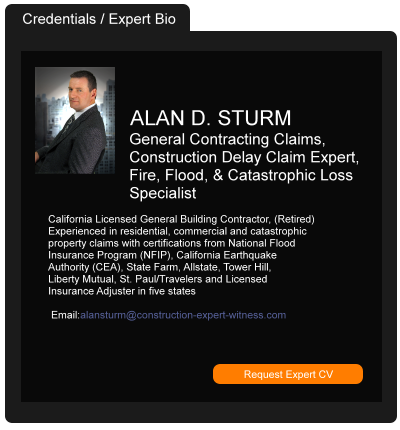Will AI Completely Transform Our Use of Computers?
July 22, 2024 —
Aarni Heiskanen - AEC BusinessLast November, I received a newsletter from Bill Gates titled “AI is about to completely change how we use computers.”
Gates begins his letter with a prediction:
“Five years from now, you won’t have to use different apps for different tasks. You’ll simply tell your device, in everyday language, what you want to do—whether it’s drafting a document, making a spreadsheet, scheduling a meeting, analyzing data, sending an email, or even buying movie tickets.“
Gates dives deeper into the topic in his
blog post.
Revolution in Computing
Gates discusses the revolutionary impact of AI on computing, comparing it to the transformative effects of mobile phones and the Internet.
Read the court decisionRead the full story...Reprinted courtesy of
Aarni Heiskanen, AEC BusinessMr. Heiskanen may be contacted at
aec-business@aepartners.fi
CGL Insurer’s Duty to Defend Insured During Pre-Suit 558 Process: Maybe?
December 20, 2017 —
David Adelstein - Florida Construction Legal UpdatesIn earlier postings, I discussed the issue of whether Florida Statutes Chapter 558′s pre-suit construction defects process triggers a CGL insurer’s duty to defend. The issue was whether Florida’s 558 pre-suit notice of a construction defect and repair process met the definition of “suit” within a standard CGL policy.
A standard CGL policy defines the term “suit” as:
“Suit” means a civil proceeding in which damages because of “bodily injury,” “property damage” or “personal and advertising injury” to which this insurance applies are alleged. “Suit” includes:
a. An arbitration proceeding in which such damages are claimed and to which the insured must submit or does submit with our consent; or
b. Any other alternative dispute resolution proceeding in which such damages are claimed and to which the insured submits with our consent.
Read the court decisionRead the full story...Reprinted courtesy of
David Adelstein, Florida Construction Legal UpdatesMr. Adelstein may be contacted at
dadelstein@gmail.com
FHFA’s Watt Says Debt Cuts Possible for Underwater Homeowners
February 05, 2015 —
Clea Benson – Bloomberg(Bloomberg) -- Fannie Mae and Freddie Mac’s overseer wants to allow debt cuts for a narrow group of borrowers who owe more than their homes are worth. The trick is figuring out a way to do it without incurring costs for taxpayers.
Federal Housing Finance Agency Director Melvin L. Watt told reporters Wednesday that he is still studying the idea of reducing principal on properties with depressed values, a step backed by housing advocates and Democratic lawmakers.
Read the court decisionRead the full story...Reprinted courtesy of
Clea Benson, Bloomberg
Court of Appeals Finds Arbitration Provision Incorporated by Reference Unenforceable
September 20, 2021 —
Garret Murai - California Construction Law BlogSubcontractors have gotten accustomed to incorporation clauses in their contracts. While an incorporation clause can incorporate any document, most typically, it’s the prime contract between the general contractor and the project owner. Subcontractors will sometimes even accept these documents sight unseen which can be a recipe for disaster. But not in the next case.
In Remedial Construction Services, LP v. AECOM, Inc., Case No. B303797 (June 15, 2021), the 2nd District Court of Appeal examined whether a subcontractor was bound to an arbitration provision contained in a prime contract that was incorporated by reference into the subcontractor’s contract. In this case, it was the prime contractor who was in for a surprise.
The Remedial Construction Case
In 2015, Shell Oil Products US, LLC entered into a prime contract with AECOM Technical Services, Inc. for the demolition, remediation and restoration of the Gaviota oil terminal in Goleta, California. AECOM in turn entered into a subcontract with Remedial Construction Services, LP to perform portions of the work. When AECOM refused to pay Remedial for delay costs asserted by Remedial, Remedial filed suit.
Read the court decisionRead the full story...Reprinted courtesy of
Garret Murai, Nomos LLPMr. Murai may be contacted at
gmurai@nomosllp.com
Conversations with My Younger Self: 5 Things I Wish I Knew Then
July 24, 2023 —
Steve Swart - The Dispute ResolverI remember the morning I became a construction law attorney. It was on my birthday several years ago when a partner called me into his office and asked me to review the A107 contract form for a large firm client. The assignment gave me a new language to speak and contract provisions that I came slowly to understand.
I quickly moved into construction litigation and would soon learn that a "fragnet" was not the newest social media app but an important part of a delay claim. I read Spearin's biography and learned how to assess recoverable damages for different claims—costs to repair, replacement and betterment, increased financing/carrying costs, and the like.
It took a lot of blood, sweat, and tears to get to where I am now. Echoing Rod Stewart’s sentiment—“I wish that I knew then, what I do now, when I was younger”—here are five tips I’d pass along to the younger me or anyone who is beginning their career as a construction lawyer:
Read the court decisionRead the full story...Reprinted courtesy of
Steve Swart, Williams MullenMr. Swart may be contacted at
sswart@williamsmullen.com
An Upward Trend in Commercial Construction?
March 28, 2012 —
Melissa Brumback, Construction Law in North CarolinaYear-end economic indicators demonstrate that private commercial construction may be increasing in 2012, primarily as demand grows for new projects built in the United States.
�According to an article in Businessweek, the Architecture Billings Index held at 52 in December, indicating a modest expansion in the market. The American Institute of Architects said that the commercial and industrial component of the number climbed to 54.1 in December, the highest in 10 months.
�The monthly survey of U.S.-based architecture firms is one of the main indicators of nonresidential construction, and these numbers suggest that modest improvement may be on the horizon.
�The information is confirmed by data from the Census Bureau that shows that spending on lodging, office, commercial and manufacturing buildings grew 8.2 percent in November to $9.2 billion from a year ago. These types of commercial and industrial projects are historically canaries in the mine and are usually the first part of the industry to improve as the economy expands.
Read the full story…
��Reprinted courtesy of Melissa Dewey Brumback of Ragsdale Liggett PLLC. Ms. Brumback can be contacted at mbrumback@rl-law.com.
Read the court decisionRead the full story...Reprinted courtesy of
Homeowner's Mold Claim Denied Due to Spoilation
April 20, 2016 —
Tred R. Eyerly – Insurance Law HawaiiThe trial court's issuance of summary judgment to the insurer for mold and water damage was upheld on appeal. Schwartz v. Encompass Indem. Co., 2016 Mich. App. LEXIS 551 (Mich. Ct. App. March 15, 2016).
The contractor was demolishing a portion of the insured's home when he discovered water damage and what appeared to be mold. The contractor believed this damage was due to improper roof installation and leaks around the windows. Further demolition was done to water-damaged portions of the home.
The insured filed a claim with Encompass for mold and "over-demolition." When Encompass's adjuster inspected the home, none of the alleged mold-affected material was present because it had been removed from the site by the contractor. The claims were denied.
Read the court decisionRead the full story...Reprinted courtesy of
Tred R. Eyerly, Insurance Law HawaiiMr. Eyerly may be contacted at
te@hawaiilawyer.com
Challenging and Defending a California Public Works Stop Payment Notice: Affidavit vs. Counter-Affidavit Process
October 21, 2019 —
William L. Porter - Porter Law GroupOne of the most effective collection procedures available to subcontractors and suppliers to California Construction projects is the “stop payment notice” procedure found under California Civil Code sections 9350 – 9364. Under this procedure, the unpaid subcontractor or supplier may serve the stop payment notice on the public entity and the direct or “prime” contractor and cause the public entity to withhold from the direct contractor 125% of the funds identified in the stop payment notice. Thereafter, funds will not generally be released unless the parties reach a settlement agreement or the issue is decided through litigation, arbitration or mediation. There is however an alternative procedure available to direct contractors to expedite the determination of whether a stop payment notice is valid and to possibly obtain an early release of the funds withheld by the public entity. This “summary proceeding” process could result in release of funds to the direct contractor in less than 30 days. The summary proceeding can also be challenged by the unpaid subcontractor or supplier. All public works contractors, subcontractors and suppliers should be aware of the process. The process for direct contractors to release a stop payment notice and for subcontractors and suppliers to challenge the process works as follows:
After a California stop payment notice has been served and the public entity has withheld funds accordingly, the direct contractor may challenge the stop payment notice by serving an “affidavit” (basically a sworn statement showing why the stop notice is not valid) on the public entity, demanding that the public entity release all funds withheld. Upon receipt of such an affidavit, the public entity will serve the subcontractor or supplier who served the stop payment notice with a copy of the affidavit, along with a “demand for release of funds”. If the stop payment notice claimant does not respond with a “counter-affidavit” by the date stated on the notice sent by the public entity (“not less than 10 days nor more than 20 days after service on the claimant of a copy of the affidavit”), then the public entity will be within its rights to release the withheld funds to the direct contractor, and the stop payment notice claimant will relinquish its stop payment notice rights.
Read the court decisionRead the full story...Reprinted courtesy of
William L. Porter, Porter Law GroupMr. Porter may be contacted at
bporter@porterlaw.com


































































